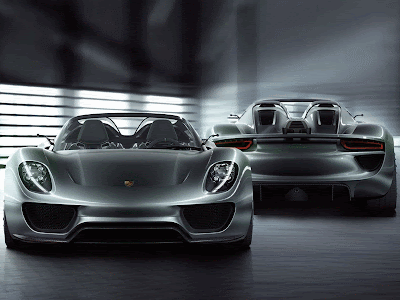 Porsche 918 Spyder
Porsche 918 SpyderThe green revolution seemed to slowly hit the automotive business. Sure, we had emissions standard a long time ago, but many states and local regions do not enforce them, even to this day. Automakers continued to make bigger and more obscene vehicles such as the Hummer, and sports cars that get single-digit gas mileage without even driving them hard.
 Porsche 918 Spyder
Porsche 918 SpyderRecently however, the automakers have been jumping on the green revolution, realizing that their high-end customers have both image-driven and genuine ecological concerns. You can't really support a charity to save silverback ape habitats and save CO2-digesting rainforests, and drive a Ford GT that gets just about the mileage of cruise ship. Eventually, the image backlash will catch up with you.
Even Ferrari has announced a hybrid version of their top line car, and other high-end luxury brands are rumored to be doing the same.
Last year at Sebring, we overheard Porsche factory people speaking in German about a hybrid racing car that could compete in the USA in 2010. We weren't entirely sure about that, as my German is a little bit spotty. Then they announced their GT3R Hybrid.
This car has been a tremendous success in its maiden race outings, proving to be even faster than the current GT3 racer, and stretching the fuel even further. Still, the technology in this car is not likely to translate to the road, which would make homologation unlikely for the car to compete for points and wins, and of course bragging rights.
Now comes the 918 Spyder. This is a road going sports car of astounding performance and even more astounding fuel economy. Some might wonder how this fits with the philosophy and image of a sports car company. Well, since Porsche's history has always been in endurance racing, this makes perfect sense. Stretching fuel further reduces time consuming pitstops and can provide an advantage. It also is the ultimate statement of efficiency, which is part of the essence of any sports or racing car, as efficiency produces speed. In this case fuel efficiency produces speed as well, over a course of time.
Beyond the aggressive styling that one might almost mistake for somewhat Italian-inspired, there is an unmistakable Porsche look to the car. with a low crouchy stance augmented by large rims and low profile rubber, the car looks as fast as it's numbers.
The interior is riddled with stylishly placed carbon fiber accents, and a classic Porsche inspired gauge set. A couple of key styling points really stand out. The mirror pylons are something we really cant seem to figure out. They are far too small to be mirrors, so we assume they are pylons for a camera system of some kind. Then there is the elevated console that hints of a chassis stiffening structure. It also happens to put the console controls in perfect ergonomic position, so it is difficult to tell which purpose it serves; perhaps both.
It certainly doesn't look like a Honda Insight (first or second generation) or a Prius. It doesn't look like anything one might think of a hybrid.
The technology of the 918 is different from the GT3R however, as it does have a battery unit. It is really more similar to the Toyota approach. The 918 uses the parallel power approach, with the car able to operate on either power source. There are about 500 horses coming from a v8 in the rear, and another 218 from electric power. So that puts a total of 718hp on tap to the right foot when you want it. There is a control that allows the driver to select various modes for more economy or more performance; each with different ratios of gas or electric power.
Porsche's stated CO2 emissions for the car are 70 grams of CO2 per Kilometer. That exceeds the Toyota Prius, which is rated as the cleanest car on the road today (except for electric vehicles) by over 20%.
As a person who does drive a Honda Insight, I get comments and reactions and questions about the car every single day. Though this is interesting, it seems to me that greener cars, hybrid, electric or alternative fuels, need to be more like what people are already willing to buy. After all, if a car gives them everything they expect in a car, and just happens to be emissions-free or get great fuel mileage, then their is really no decision to make.
Getting back to the Porsche 918 Spyder, which is currently only a concept car, we hear that this car could quickly transition to production based on response. With the response it has already generated, we would say that is a forgone conclusion.








.jpg)